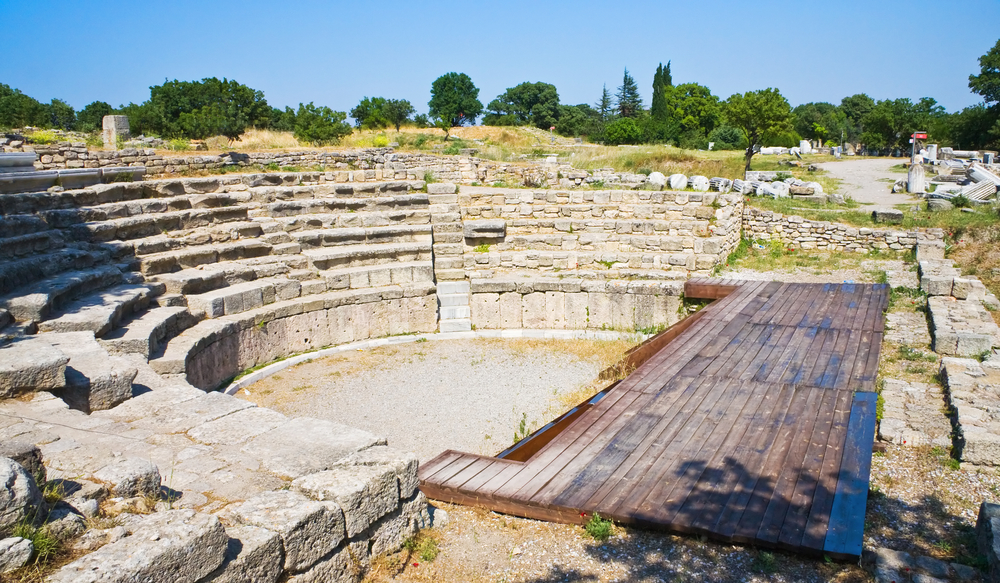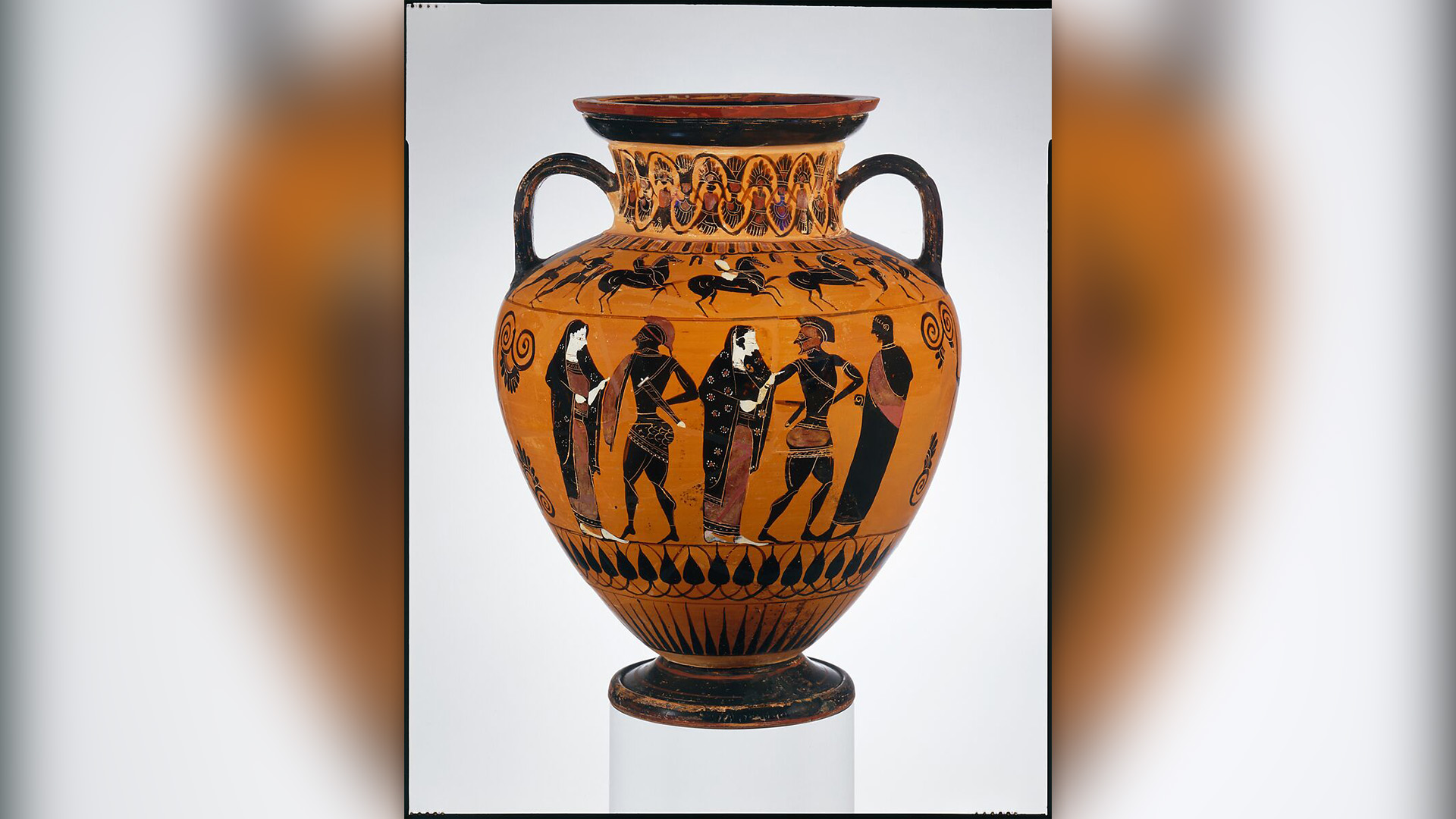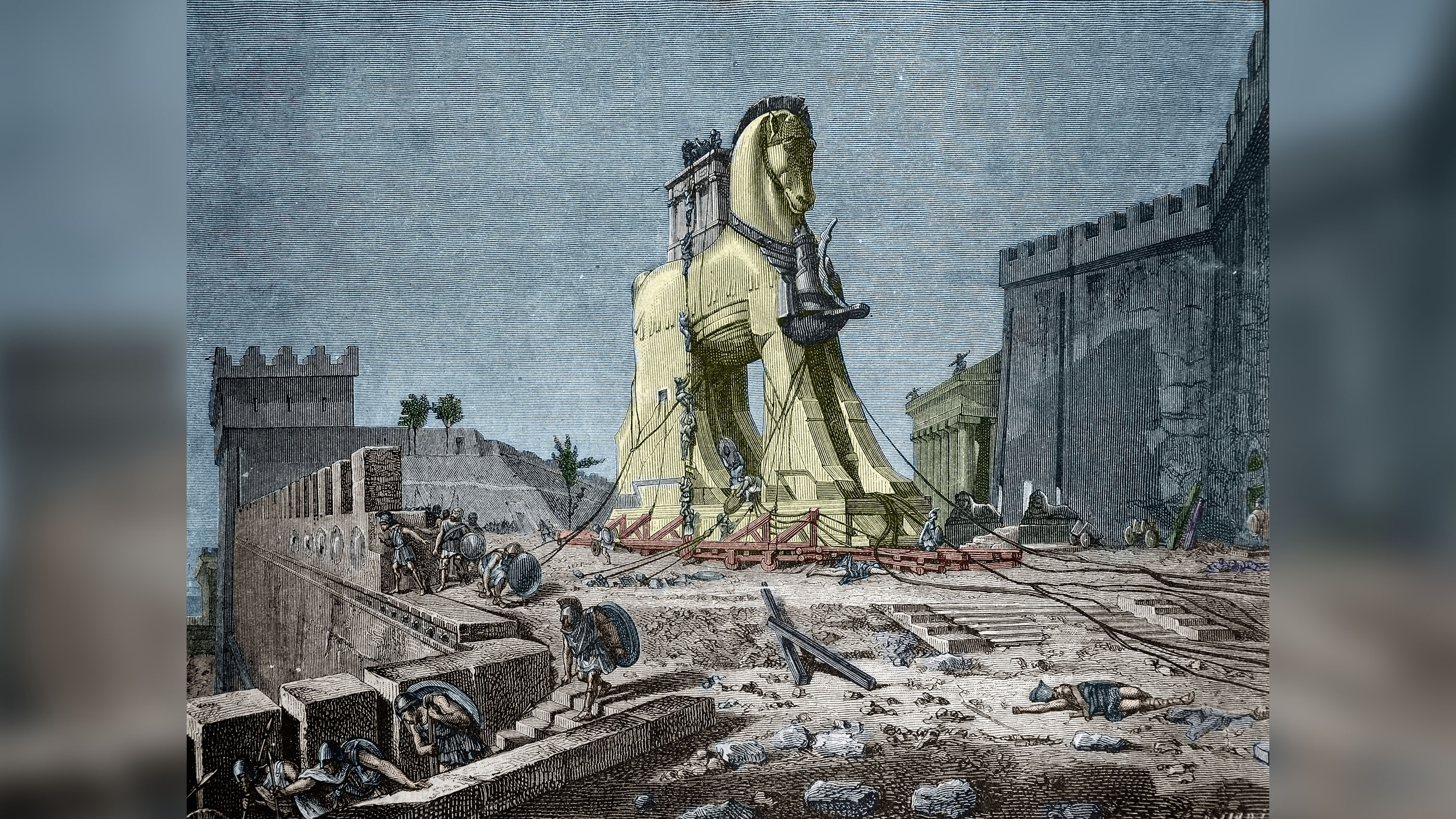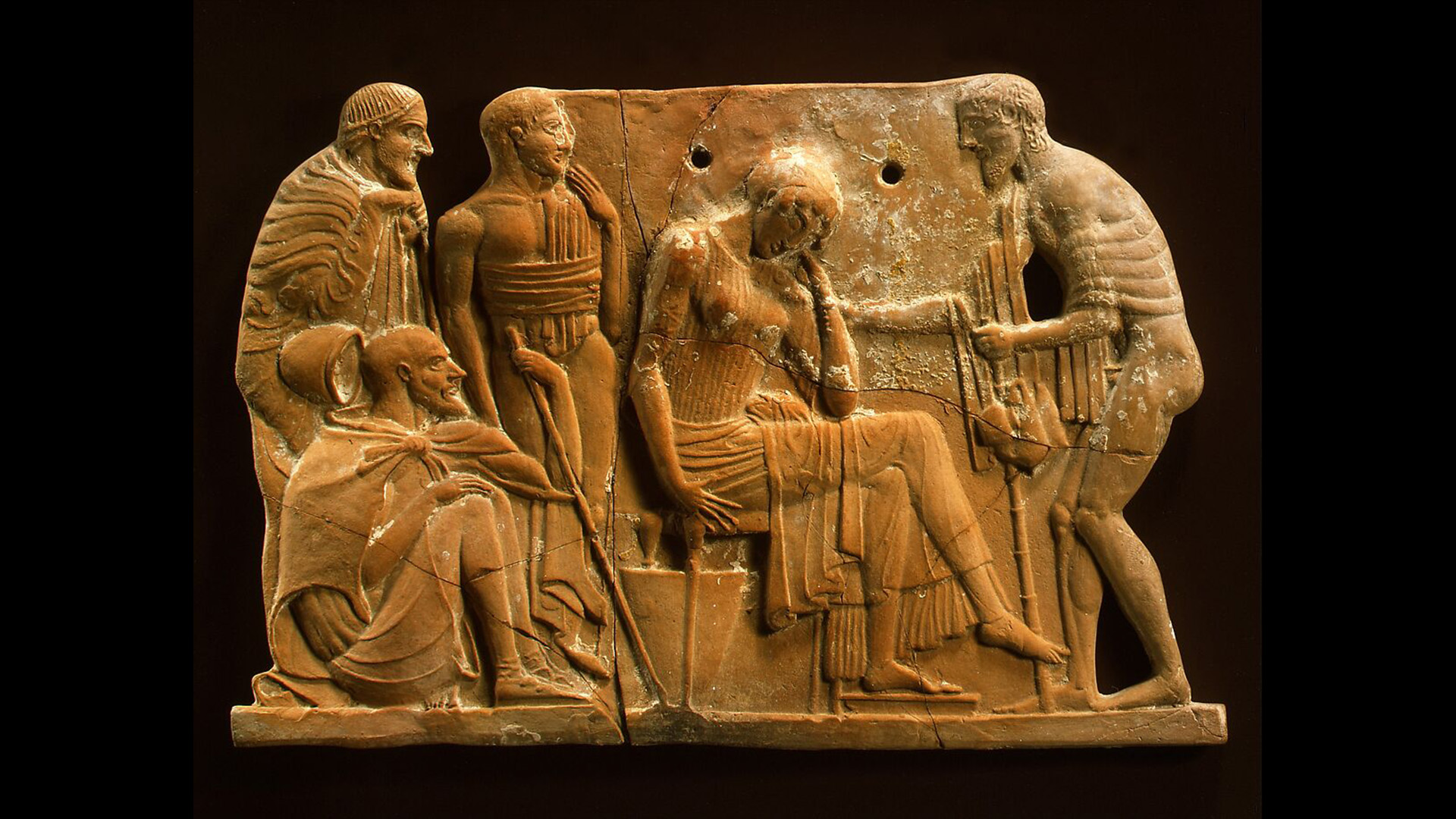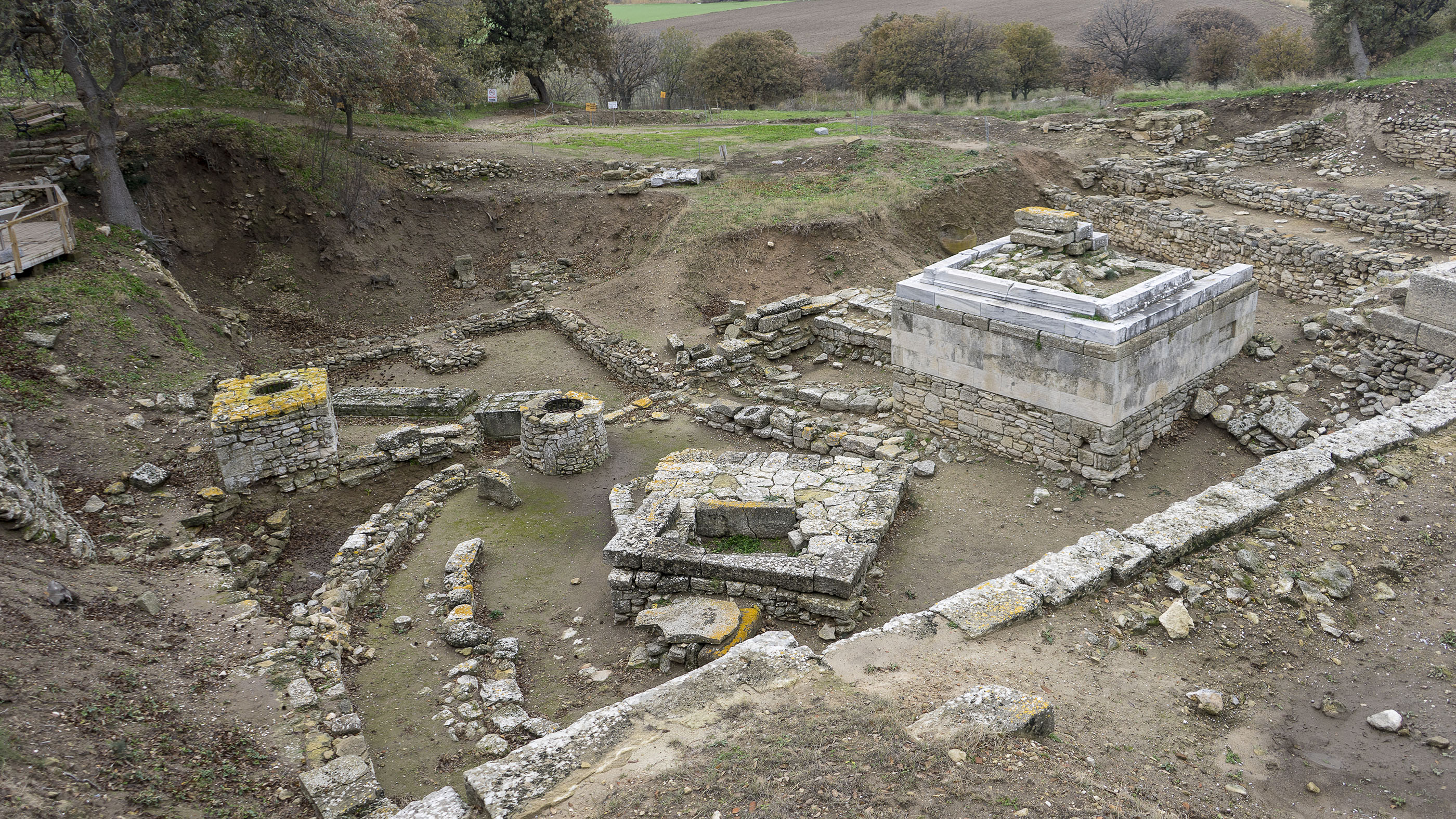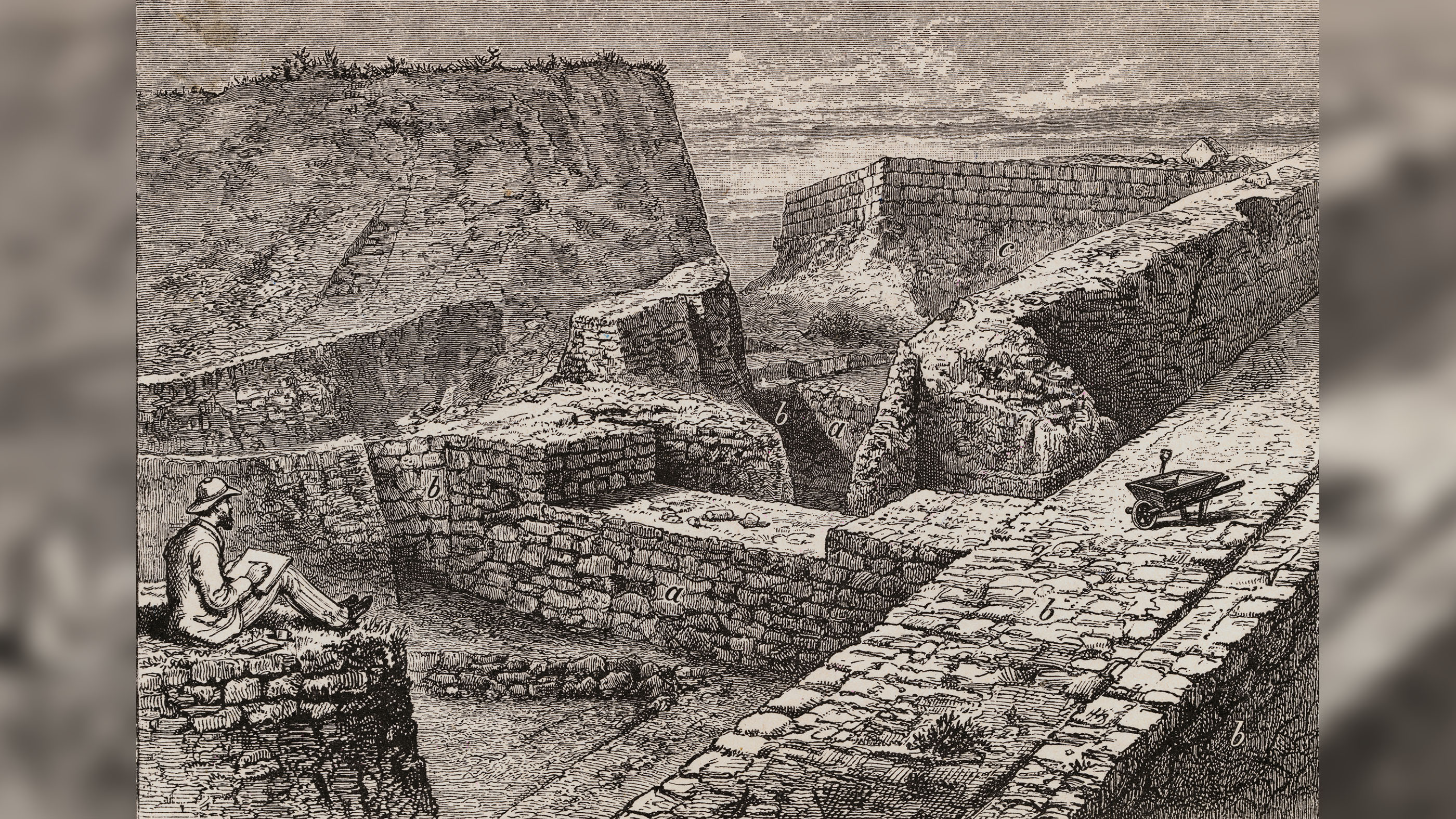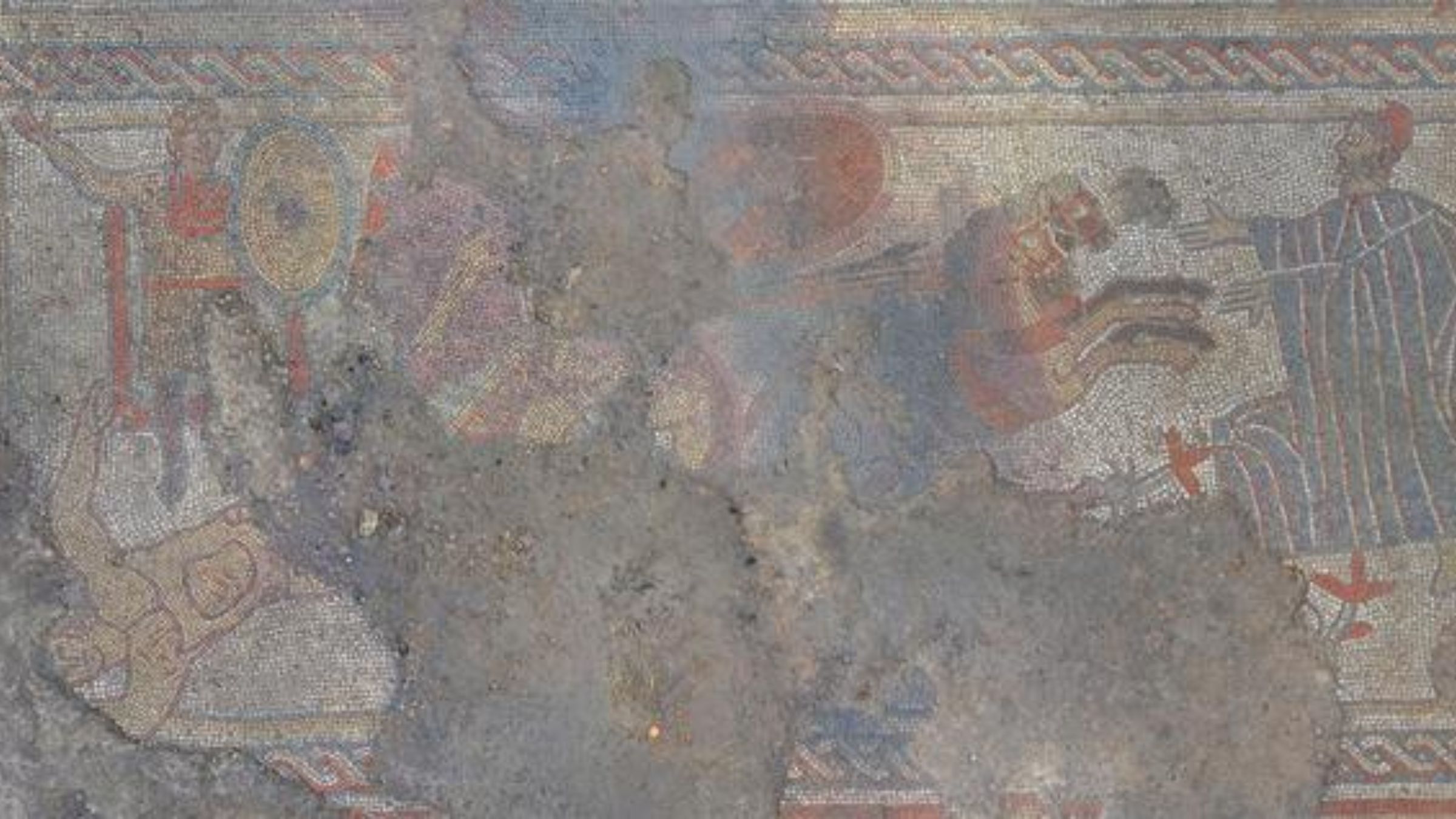Ancient Troy: The city and the legend of the Trojan War
Troy is an ancient city in modern-day Turkey, but it is also the setting for the legendary Trojan War in Homer's epic poems the "Iliad" and the "Odyssey."

Troy is an ancient city and archaeological site in modern-day Turkey, but is also famously the setting for the legendary Trojan War in Homer's epic poems the "Iliad" and the "Odyssey."
In legend, the city of Troy was besieged for 10 years and eventually conquered by a Greek army led by King Agamemnon. This "Trojan War erupted because Helen, a queen from Sparta, was abducted by Paris, the son of Troy's King Priam, according to Homer's epic poem "Iliad." Throughout the "Iliad," the gods — including Hera, Athena and Poseidon supporting the Greeks, and Aphrodite, Apollo and Ares rooting for the Trojans — constantly intervene.
Troy also refers to a real ancient city, also known as Hisarlık, located on the northwest coast of Turkey about 3 miles (4.8 kilometers) from the Dardanelles. It has been identified by many as the legendary Troy featured in Homer's poems. Whether the Trojan War actually took place, and whether the site in northwest Turkey is the same Troy, are matters of debate.
The idea that Hisarlık is the real-life location of the city portrayed by Homer goes back at least 2,700 years, when the ancient Greeks were colonizing the west coast of what is now Turkey. In the 19th century, the idea again came to popular attention when Heinrich Schliemann, a German businessman and early archaeologist, conducted a series of excavations at Hisarlık and discovered treasures he claimed belonged to King Priam.
The legend of Troy and the Trojan horse
The Trojan War is thought to have taken place near the end of the Bronze Age, around or before 1200 B.C. At that time, a Greek civilization we call the Mycenaean was collapsing. The Mycenaens built great palaces and developed a system of writing, and their culture dominated the Greek world for about 300 years before their decline. In the "Iliad," the Greek forces are led by Agamemnon, the king of Mycenae.
The earliest accounts of this war come from Homer, a Greek author who lived around the eighth century B.C. — several centuries after the war supposedly took place. Homer's works were told through oral stories and do not appear to have been written down until even later, likely during the sixth century B.C.
Homer's "Iliad" is set in the 10th year of the Greeks' siege of Troy and tells of a series of events that appear to take place over a few weeks. The story makes clear that the siege had taken its toll on the Greek force sent to recover Helen. The "timbers of our ships have rotted away and the cables are broken and far away are our wives and our young children," the poem says (translation by Richmond Lattimore).
Get the world’s most fascinating discoveries delivered straight to your inbox.
By this point, the war had essentially become a stalemate, with the Greeks unable to take the city and the Trojans unable to drive the invading force into the sea. We "sons of the Achaians [Greeks] outnumber the Trojans — those who live in the city; but there are companions from other cities in their numbers, wielders of the spear to help them," the "Iliad" says (translation by Eric Robinson).
A number of key events happen in the poem, including a duel between the Trojan Prince Paris and Menelaos (or Menelaus), the king of Sparta and husband of Helen. The winner is supposed to receive Helen as a prize, ending the war. However, the gods intervene to break up the duel before it is finished, and the war continues.
Another important duel occurs near the end of the poem between Achilleus (or Achilles) and a great Trojan warrior named Hektor (or Hector). The Trojan knows that he's no match for the Greek warrior and initially runs three laps around Troy, with Achilleus chasing him. Finally, the gods force him to face the Greek warrior, and Hektor is killed.
Who won the Trojan War?
Contrary to popular belief, the "Iliad" does not end with the destruction of Troy but with a temporary truce, after which the fighting presumably continues. Another Homeric epic poem called the "Odyssey" is set after the destruction of the city and features the Greek hero Odysseus trying to get home. That poem briefly references how the Greeks took Troy using the famous "Trojan Horse." The Greeks left a gift to the Trojans "of a giant wooden horse as an offering to the goddess Athena" that concealed Greek warriors within, while the "Greek army, encamped outside the city walls, made as if to sail home," Armand D'angour, professor of Classics at Oxford University, wrote in a BBC article in 2014. The Trojans took the offering into the city, and the Greeks emerged from the horse and attacked the unsuspecting Trojans.
"What a thing was this, too, which that mighty man wrought and endured in the carven horse, wherein all we chiefs of the Argives were sitting, bearing to the Trojans death and fate!" reads part of the poem (Translation by A.T. Murray through Perseus Digital Library).
Like the "Iliad," the "Odyssey" was also probably not written down until sometime after the death of Homer. One of the earliest surviving copies of the "Odyssey" is a fragment of the text that appears on a fifth century B.C. pottery shard found at Olbia in modern-day Ukraine.
The city's origin
The site of Hisarlık, in northwest Turkey, has been identified as the site of the legendary Troy since ancient times. Archaeological research shows that it was inhabited for almost 4,000 years, starting around 3500 B.C. The city was constantly changing, and the settlement was destroyed and rebuilt repeatedly: After one city was destroyed, a new city would be built on top of it, creating a human-made mound called a "tell."
"There is no one single Troy; there are at least 10, lying in layers on top of each other," Gert Jan van Wijngaarden, a researcher at the University of Amsterdam in the Netherlands, wrote in a chapter of the book "Troy: City, Homer and Turkey" (W Books, 2013).
Van Wijngaarden noted that archaeologists have had to dig deep to find remains of the first settlement, and from what they can tell it was a "small city surrounded by a defensive wall of unworked stone." Outside the largest gate was a stone with an image of a face — perhaps a deity welcoming visitors to the city.
Troy took off in the period after 2550 B.C. The city "was considerably enlarged and furnished with a massive defensive wall made of cut blocks of stone and rectangular clay bricks," van Wijngaarden wrote. He noted that the settlement's citadel featured houses of the "megaron" type, which contained "an elongated room with a hearth and open forecourt."
When Heinrich Schliemann excavated this level of Troy in 1873, he discovered a cache of treasure, which he believed belonged to King Priam. "The collection of weapons, gold, silver, electrum, copper and bronze vessels, gold jewellery, including thousands of gold rings, and a range of other objects made of precious materials apparently came to light close to the outer side of the city wall near the building which Schliemann designated as the royal palace," Trevor Bryce, a researcher at the University of Queensland in Australia, wrote in his book "The Trojans and their Neighbours" (Routledge, 2006).
Some researchers have speculated that these treasures were not found all in one hoard but were rather precious objects from across the site, which Schliemann gathered over a number of weeks. While Schliemann believed he had found Priam's treasures, it became clear in the following decades that these artifacts date back more than 4,000 years — a millennium too early for Priam.
Homer's Troy?
Two other phases, or layers, of Troy that date between roughly 1700 B.C. and 1190 B.C. may be the city that featured in Homer's works. Bryce noted that during this period the city's defenses were formidable.
"The walls, surmounted by mud-brick breastworks, once reached a height of nine meters [30 feet]. Several watchtowers were built into these walls, the most imposing of which is the northeastern bastion, which served to reinforce the citadel's defences as well as offer a commanding view over the Trojan plain," he wrote.
The exact size of the city is disputed. Archaeological work on the site shows that there was a "lower city" beyond the citadel, bringing its total size to about 30 hectares (74 acres), archaeologist Manfred Korfmann, who led excavations at the site, wrote in a study published in the book "Troy: From Homer's Iliad to Hollywood Epic" (Blackwell Publishing, 2007).
"This Troy had a large residential area below a strongly fortified citadel. As far as we know today, the citadel was unparalleled in its region and in all of southeastern Europe," he wrote. The extent of the residential area is a topic of debate among scholars, with some arguing that Korfmann overestimated its extent.
But was this really the same city as the one depicted by Homer? While scholars have noted that the topography of Troy as told in the legend does seem to generally match that of the real-life city, a key problem with identifying it as Homer's Troy is the way the city was destroyed. Cracks in its walls suggest that it was hit by an earthquake around 1300 B.C., possibly followed by an uprising or attack. "There are also some indications of fire, and slingstones in the destruction layer (suggesting) the possibility that there might have been some fighting," van Wijngaarden wrote. "Nevertheless an earthquake appears to have caused the most damage." An interesting fact is that the city was rebuilt after its destruction by the same population groups as before, rather than by a foreign Greek force, van Wijngaarden noted.
While there is also archaeological evidence that the city was attacked in 1190 B.C., there are once again problems with the idea that it was carried out by a Greek force. By this time, Greece's Mycenaean civilization had collapsed. Additionally, archaeologists have found ceramics and bronze axes at Troy that originate from southeast Europe, suggesting that people from this area may have conquered, or otherwise moved into the city around this time. Around 1190 B.C. the Hittite Empire was in decline and may not have been able to assist Troy.
Later Troy: A venerated site
Troy was abandoned around 1000 B.C. but was reoccupied in the eighth century B.C., around the time Homer lived. The Greeks called the reoccupied city "Ilion."
Many scholars believe that the people who resettled Troy were Greek colonists, although there is some evidence that people who already lived in the area also settled in the reoccupied settlement. In 2014, a team of scholars published research in the Oxford Journal of Archaeology that examined amphorae at Troy dating to after 1000 B.C., and found that they were locally made rather than imported from Greece, leading the researchers to conclude that the new settlers were not exclusively from Greece.
For its first few centuries, Ilion was a modest settlement, although it later grew thanks to its association with Homer's works. The "new settlers had no doubt that the place they were preparing to occupy was the fabled setting of the Trojan War," Bryce wrote, and in later times its inhabitants took advantage of this to draw in political support and ancient tourists.
Xerxes, the Persian king (lived 519-466 B.C.), stopped to pay homage to Troy on his way to attack Greece around 480 B.C., and, most notably, Alexander the Great (356 to 323 B.C.) did the same on his way to conquer the Persian Empire, and he granted it special status within his empire.
"It is said that the city of the present Ilians was for a time a mere village, having its temple of Athena, a small and cheap temple," wrote Strabo, an ancient Greek geographer and historian who lived from 64 B.C. to A.D. 23 . When "Alexander went up there after his victory at the Granicus River he adorned the temple with votive offerings, gave the village the title of city, and ordered those in charge to improve it with buildings, and that he adjudged it free and exempt from tribute; and that later, after the overthrow of the Persians, he sent down a kindly letter to the place, promising to make a great city of it." (Translation by H.L. Jones, through Perseus Digital Library)
Troy's special status continued into the period of Roman rule, when the Romans conquered the region in 129 B.C. The Romans believed that Aeneas, one of Troy's heroes, was an ancestor of Romulus and Remus, ancient Rome's legendary founders. Troy's inhabitants took advantage of this mythology, and it became a "popular destination for pilgrims and tourists," Bryce wrote. He noted that in this phase the city became larger than at any time before, including when the Trojan War was said to have taken place.
However, during the Middle Ages, Troy fell into decline, and by the 13th century, the city had been reduced to a modest farming community.
Troy today
In the 1860s Frank Calvert carried out excavations at the site and was convinced that the site was likely Troy and his work helped persuade Heinrich Schliemann to carry larger excavations at the site starting in 1870. Schliemann dug deep into the city, most famously unearthing treasures that he incorrectly attributed to King Priam. His work greatly increased the fame of the site.
Archaeological work continued off and on over the next 150 years. As archaeological techniques were refined and new scientific tests— such as radiocarbon dating — were discovered the different levels of Troy could be more accurately dated. This dating was important as it showed what levels could be associated with the Trojan war and what levels were too early. They also proved that the artifacts that Schliemann attributed to King Priam were created almost a millennium before Priam lived.
Today, Troy is a UNESCO World Heritage site and a popular attraction for tourists. Excavations continue at Troy but are now led by archaeologists from Turkey, the most recent digs being led by Rüstem Aslan, a professor at Çanakkale Onsekiz Mart Üniversitesi. The fact that work is now led by Turkish archaeologists is important as historically work was led by archaeologists from Europe or the United States. Aslan's team found that Troy may have been founded around 3500 B.C., which makes it about 600 years older than originally believed, says a report in Hurriyet Daily News.
A new museum was opened at Troy in 2018; its displays include a collection of gold jewelry that was repatriated to Turkey from the Penn Museum. The jewelry was returned after research revealed that it was taken from Troy sometime in the early-mid 20th century, C. Brian Rose, a professor of archaeology at the University of Pennsylvania, wrote in an article published in 2017 in the Journal of Eastern Mediterranean Archaeology and Heritage Studies.
Was there a Trojan War?
The big question researchers still face is, was there ever a Trojan War?
Unfortunately, there are few written clues for scholars to go on. The only written record found at Troy that dates to before the Greek colonization in the eighth century B.C., is a seal written in a language called Luwian, which was perhaps brought to Troy from elsewhere in Turkey.
Archaeologists unearthed historical records at Hattusa, the capital city of the Hittite Empire, in modern-day Turkey in the late 19th and early centuries. The Hittite Empire thrived in the region from roughly 1750 B.C. to 1200 B.C, and Hittite records claim that Troy (which the Hittites called "Wilusa") was likely a vassal state of the empire around the time of the Trojan War, British Museum curators Lesley Fitton and Alexandra Villing wrote in a blog post.
This means that Troy may not have been an independent kingdom, something that contradicts the story told by Homer. The records do, however, mention fighting between the Hittites and people from Greece over Wilusa, the curators noted, suggesting that it's possible that this fighting could have served as a basis for the Trojan War stories.
As mentioned earlier, the archaeological evidence at Harsalik is ambiguous regarding the Trojan War: While there is evidence that Troy was attacked around the time period the stories are set in, there is no strong evidence that the city was assailed by a Greek force.
These issues leave researchers with a mystery about the truth of the Trojan War. "At one end of the spectrum of opinion is the conviction that there was indeed a war and that it was pretty much as the poet described it," Bryce wrote. "From that we pass through varying degrees of scepticism and agnosticism to the other end of the spectrum where the tradition is consigned wholly to the realm of fantasy."
Korfmann, a modern-day excavator of Hisarlık, believes that the story of the Trojan War contains some truth. "According to the current state of our knowledge, the story told in the "Iliad" most likely contains a kernel of historical truth or, to put it differently, a historical substrate," he wrote. "Any future discussions about the historicity of the Trojan War only make sense if they ask what exactly we understand this kernel or substrate to be."
Additional resources
Troy is a UNESCO World Heritage Site and its entry can be read here. The site of the lost city of Tenea was discovered in Greece in 2018. Ancient historians say that the people of Tenea believed that they were descendants of Trojan prisoners taken to the city. Another recent find is a woman who died at Troy of a pregnancy related cause during the Middle Ages.
Bibliography
Bryce, Trevor "The Trojans & Their Neighbours" Routledge, 2006
Carolyn Aslan, Lisa Kealhofer and Peter Grave "The Early Iron Age at Troy Reconsidered" Oxford Journal of Archaeology 33, 3, August 2014
Günay Uslu, Jorrit Kelder and Ömer Faruk Sarıoğlu eds., "Troy: City, Homer and Turkey" W Books, 2013
Rose, Brian C, "Beyond the UNESCO Convention: The Case of the Troy Gold in the Penn Museum" Journal of Eastern Mediterranean Archaeology and Heritage Studies 5, no 1, 2017
Winkler, Martin ed., "Troy: From Homer's Iliad to Hollywood Epic" Blackwell Publishing, 2007

Owen Jarus is a regular contributor to Live Science who writes about archaeology and humans' past. He has also written for The Independent (UK), The Canadian Press (CP) and The Associated Press (AP), among others. Owen has a bachelor of arts degree from the University of Toronto and a journalism degree from Ryerson University.


